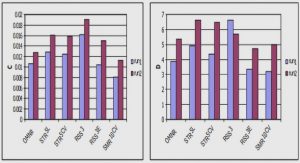Get Complete Project Material File(s) Now! »
Basic Principles of the Doha Declaration
The only form of reconsideration made so far to the TRIPS Agreement has been the Doha Declaration even though there is a provision for regular review.321 The 4th WTO Ministerial meeting at Doha, Qatar adopted, on the 14 November 2001, a Declaration on the TRIPS Agreement and Public Health.322 Developing countries and non-governmental organisations that the TRIPS Agreement and in particular the patent provisions represent a barrier to effective access to medicines.323 The Declaration was conceived mainly as a result of apprehensions about the likely impact of the TRIPS Agreement on access to medicines.324 The Declaration stresses that the TRIPS Agreement does not and should not preclude the use of the flexibilities by WTO members to protect public health. The Declaration took special notice of the gravity of the problems afflicting developing and least developed countries with regard to diseases like HIV/AIDS, tuberculosis, malaria and other epidemics.325 The Declaration clarifies that the TRIPS Agreement should be interpreted in the light of Articles 7 and 8,326 and that members have the right to grant compulsory licences and to determine the grounds upon which such licences are granted.327 Members have a right to determine what constitutes a national emergency or other circumstances of extreme urgency328 and each member is free to establish its own regime for such exhaustion without challenge, however, it is guided by the rules of most favoured nation (MFN) and national treatment (NT).329 WTO members, who may face difficulty in using the compulsory licensing under the TRIPS Agreement as a result of insufficient or no manufacturing capacities in the pharmaceutical sector, were also recognised and the TRIPS Council was instructed to find a quick solution to this problem and report to the General Council before the end of 2002. Despite the request for a quick solution, the decision that would allow the importation of cheaper generic drugs did not come till 30 August 2003.
Access to Knowledge in Nigeria
Knowledge as an essential currency for propagating economic growth and development cannot be over-emphasised. Access to knowledge (A2K) has come to the fore-front of many discussions and forums.379 In recent times it has been a source of concern to developing countries and least developed countries. Access to educational materials, especially in the field of higher scientific and technical education, is crucial for the development of human resources in order to contribute to the economic progress of developing countries. The concern is as a result of the advent of the TRIPS Agreement which raises many questions regarding the constraint on the growth of knowledge and an equitable access to knowledge resources. The challenge is how to guarantee continuous generation and dissemination of knowledge. At this juncture it is pertinent to ask if there is a problem in relation to access to knowledge in Nigeria. What is the cause of this problem? Is the problem solvable by amending the laws or not? What has been the government‘s response to the problem in terms of policies and strategies? These questions need to be considered in the context that access to knowledge is relative and depends on a number of factors. A major challenge that is faced in relation to copyright is access to knowledge, mainly in the area of access to learning materials. Copyright-enabled industries determine the price and the availability of copyrighted materials. In examining the effect of copyright on access to knowledge, it is important to know what knowledge consists of.
CHAPTER 1:General Introduction
1.1 Background
1.2 Research Problem and Statement
1.3 Purpose of the Research
1.4 Research Question
1.5 Significance of the Research
1.6 Existing Studies
1.7 Research Methodology
1.8 Limitation of Research
1.9 Chapter Overview
CHAPTER 2: Intellectual Property in International Context
2.1 Introduction
2.2 Theories on the Recognition and Reception of International Law
2.3 World Intellectual Property Organisation
2.4 World Trade Organisation (WTO)
2.5 World Health Organisation
2.6 United Nations Educational, Scientific and Cultural Organisation (UNESCO)
2.7 Conclusion
CHAPTER 3: Substantive Provisions of the TRIPS Agreement
3.1 Introduction
3.2 Agreement on Trade Related Aspects of Intellectual Property
3.3 Substantive Provisions of the TRIPS Agreement
3.4 Doha Declaration on the TRIPS Agreement
3.5 Other Substantive Provisions of the TRIPS Agreement
3.6 Conclusion
CHAPTER 4: Copyrights and Related Rights
4. 1 Introduction
4.2 Copyright in Nigeria
4.3 Nigerian Copyright Law and TRIPS Agreement: Compliance
4.4 Impact Assessment
4.5 Required Modifications
4.6 Flexibilities in relation to Copyright and Related Rights
4.7 Conclusion
CHAPTER 5: Regulatory Framework of Trade Marks in Nigeria
5.1 Introduction
5.2 Trade Marks Law in Nigeria
5.3 The Level of Compliance of the Nigerian Trade Mark Laws to the TRIPS Agreement.
5.4 Geographical Indications
5.5 Sector-specific Implication of the TRIPS Agreement on Trade Marks
5.6 Flexibilities under the TRIPS Agreement
5.7 Modifications Required to the Trade Marks Act by TRIPS Agreement
5.8. Conclusion
CHAPTER 6: Statutory Framework of Patent Law in Nigeria
6.1 Introduction
6.2 Patent Laws in Nigeria
6.3 Patents: Compliance
6.4 Sector-specific Implication of the TRIPS Agreement on Patents
6.5. Flexibilities under the TRIPS Agreement and the Doha Declaration
6.6 Modification required in the Patent and Designs Act
6.7. Conclusion
CHAPTER 7: Enforcement and Challenges to Intellectual Property Rights and Laws in Nigeria
7.1 Introduction
7.2 Sections A: Enforcement of intellectual Property Rights
7.3 Enforcement required under the TRIPS Agreement
7.4 Flexibilities under the TRIPS Agreement
7.5 Sections B: Challenges to intellectual Property Rights
7.6 Conclusion
CHAPTER 8: Conclusions and Recommendations
8.1 Introduction
8.2 Copyrights
8.3 Trade marks
8.4 Patents
8.5 Enforcement
8.6 Final Remarks





